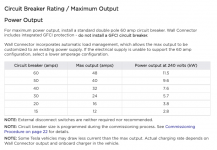Hold on Seirra, dont waste that money, The last Tesla charger I did was called a "wall connector" and I hard wired right into it.
My understanding is all car chargers use a single voltage as in '240' volt, we dont use a 14-50 or pull a neutral.
Others I have put on a 6-50 recept.
EDIT: You program them to whatever breaker they are on
From the manual:

My understanding is all car chargers use a single voltage as in '240' volt, we dont use a 14-50 or pull a neutral.
Others I have put on a 6-50 recept.
EDIT: You program them to whatever breaker they are on
From the manual:


